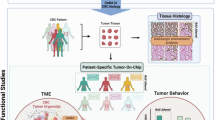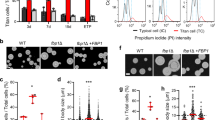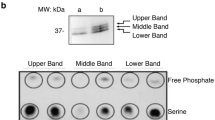Abstract
Upon growth factor stimulation, the scaffold protein, Gab1, is tyrosine phosphorylated and subsequently the adaptor protein, Crk, transmits signals from Gab1. We have previously shown that Crk overexpression, which is detectable in various human cancers, induces tyrosine phosphorylation of Gab1 without extracellular stimuli. In the present study, the underlying mechanisms were further investigated. Mutational analyses of CrkII demonstrated that the SH2 domain, but not the SH3(N) or the regulatory Y221 residue of CrkII, is critical for the induction of Gab1-Y307 phosphorylation. SH2 mutation of CrkII also decreased the interaction with Gab1. In GST pull-down assay, Crk-SH2 bound to wild-type Gab1, whereas Crk-SH3(N) interacted with the Gab1 mutant, which lacks the clustered tyrosine region (residues 242-410). Tyrosine phosphorylation of Gab1 was induced by all Crk family proteins, but not other SH2-containing signalling adaptors. Src-family kinase inhibitor, PP2, abrogates Crk-induced tyrosine phosphorylations of Gab1. Y307 phosphorylation was undetectable in fibroblasts lacking Src, Yes, and Fyn, even upon overexpression of Crk, whereas cells lacking only Yes and Fyn still contained Gab1 with phosphorylated Y307. Furthermore, Crk induced the phosphorylation of Src-Y416; accordingly the interaction between Crk and Csk was increased. The Gab1-Y307F mutant failed to localize near the plasma membrane even upon HGF stimulation and decreased cell migration. Moreover, Gab1-Y307F disturbed the localization of Crk, FAK, and paxillin, which are the typical components of focal adhesions. Taken together, these results indicate that Crk facilitates tyrosine phosphorylation of Gab1-Y307 through Src, contributing to the organization of focal adhesions and enhanced cell migration, thereby possibly promoting human cancer development.
Similar content being viewed by others
Log in or create a free account to read this content
Gain free access to this article, as well as selected content from this journal and more on nature.com
or
References
Schlessinger J . Cell signaling by receptor tyrosine kinases. Cell 2000; 103:211–225.
Yaffe MB . Phosphotyrosine-binding domains in signal transduction. Nat Rev Mol Cell Biol 2002; 3:177–186.
Hanafusa H, Torii S, Yasunaga T, Nishida E . Sprouty1 and Sprouty2 provide a control mechanism for the Ras/MAPK signalling pathway. Nat Cell Biol 2002; 4:850–858.
Gu H, Neel BG . The "Gab" in signal transduction. Trends Cell Biol 2003; 13:122–130.
Nishida K, Hirano T . The role of Gab family scaffolding adapter proteins in the signal transduction of cytokine and growth factor receptors. Cancer Sci 2003; 94:1029–1033.
Furge KA, Zhang YW, Vande Woude GF . Met receptor tyrosine kinase: enhanced signaling through adapter proteins. Oncogene 2000; 19:5582–5589.
Chan PC, Chen YL, Cheng CH, et al. Src phosphorylates Grb2-associated binder 1 upon hepatocyte growth factor stimulation. J Biol Chem 2003; 278:44075–44082.
Schaeper U, Vogel R, Chmielowiec J, Huelsken J, Rosario M, Birchmeier W . Distinct requirements for Gab1 in Met and EGF receptor signaling in vivo. Proc Natl Acad Sci USA 2007; 104:15376–15381.
Mayer BJ, Hamaguchi M, Hanafusa H . A novel viral oncogene with structural similarity to phospholipase C. Nature 1988; 332:272–275.
Matsuda M, Tanaka S, Nagata S, Kojima A, Kurata T, Shibuya M . Two species of human CRK cDNA encode proteins with distinct biological activities. Mol Cell Biol 1992; 12:3482–3489.
Feller SM, Knudsen B, Hanafusa H . c-Abl kinase regulates the protein binding activity of c-Crk. EMBO J 1994; 13:2341–2351.
Hasegawa H, Kiyokawa E, Tanaka S, et al. DOCK180, a major CRK-binding protein, alters cell morphology upon translocation to the cell membrane. Mol Cell Biol 1996; 16:1770–1776.
Tanaka S, Morishita T, Hashimoto Y, et al. C3G, a guanine nucleotide-releasing protein expressed ubiquitously, binds to the Src homology 3 domains of CRK and GRB2/ASH proteins. Proc Natl Acad Sci USA 1994; 91:3443–3447.
Feller SM . Crk family adaptors-signalling complex formation and biological roles. Oncogene 2001; 20:6348–6371.
Kobashigawa Y, Sakai M, Naito M, et al. Structural basis for the transforming activity of human cancer-related signaling adaptor protein CRK. Nat Struct Mol Biol 2007; 14:503–510.
Linghu H, Tsuda M, Makino Y, et al. Involvement of adaptor protein Crk in malignant feature of human ovarian cancer cell line MCAS. Oncogene 2006; 25:3547–3556.
Nishihara H, Tanaka S, Tsuda M, et al. Molecular and immunohistochemical analysis of signaling adaptor protein Crk in human cancers. Cancer Lett 2002; 180:55–61.
Watanabe T, Tsuda M, Makino Y, et al. Adaptor molecule Crk is required for sustained phosphorylation of Grb2-associated binder 1 and hepatocyte growth factor-induced cell motility of human synovial sarcoma cell lines. Mol Cancer Res 2006; 4:499–510.
Lamorte L, Royal I, Naujokas M, Park M . Crk adapter proteins promote an epithelial-mesenchymal-like transition and are required for HGF-mediated cell spreading and breakdown of epithelial adherens junctions. Mol Biol Cell 2002; 13:1449–1461.
Sakkab D, Lewitzky M, Posern G, et al. Signaling of hepatocyte growth factor/scatter factor (HGF) to the small GTPase Rap1 via the large docking protein Gab1 and the adapter protein CRKL. J Biol Chem 2000; 275:10772–10778.
Schaeper U, Gehring NH, Fuchs KP, Sachs M, Kempkes B, Birchmeier W . Coupling of Gab1 to c-Met, Grb2, and Shp2 mediates biological responses. J Cell Biol 2000; 149:1419–1432.
Hanke JH, Gardner JP, Dow RL, et al. Discovery of a novel, potent, and Src family-selective tyrosine kinase inhibitor. Study of Lck- and FynT-dependent T cell activation. J Biol Chem 1996; 271:695–701.
Boccaccio C, Comoglio PM . Invasive growth: a MET-driven genetic programme for cancer and stem cells. Nat Rev Cancer 2006; 6:637–645.
Roshan B, Kjelsberg C, Spokes K, Eldred A, Crovello CS, Cantley LG . Activated ERK2 interacts with and phosphorylates the docking protein GAB1. J Biol Chem 1999; 274:36362–36368.
Gual P, Giordano S, Williams TA, Rocchi S, Van Obberghen E, Comoglio PM . Sustained recruitment of phospholipase C-gamma to Gab1 is required for HGF-induced branching tubulogenesis. Gene 2000; 19:1509–1518.
Sabe H, Shoelson SE, Hanafusa H . Possible v-Crk-induced transformation through activation of Src kinases. J Biol Chem 1995; 270:31219–31224.
Okada M, Nada S, Yamanashi Y, Yamamoto T, Nakagawa H . CSK: a protein-tyrosine kinase involved in regulation of src family kinases. J Biol Chem 1991; 266:24249–24252.
Sabe H, Okada M, Nakagawa H, Hanafusa H . Activation of c-Src in cells bearing v-Crk and its suppression by Csk. Mol Cell Biol 1992; 12:4706–4713.
Ilic D, Furuta Y, Kanazawa S, et al. Reduced cell motility and enhanced focal adhesion contact formation in cells from FAK-deficient mice. Nature 1995; 377:539–544.
Niwa H, Yamamura K, Miyazaki J . Efficient selection for high-expression transfectants with a novel eukaryotic vector. Gene 1991; 108:193–199.
Gotoh N, Toyoda M, Shibuya M . Tyrosine phosphorylation sites at amino acids 239 and 240 of Shc are involved in epidermal growth factor-induced mitogenic signaling that is distinct from Ras/mitogen-activated protein kinase activation. Mol Cell Biol 1997; 17:1824–1831.
Higashi H, Tsutsumi R, Muto S, et al. SHP-2 tyrosine phosphatase as an intracellular target of Helicobacter pylori CagA protein. Science 2002; 295:683–686.
Tanaka S, Hattori S, Kurata T, et al. Both the SH2 and SH3 domains of human CRK protein are required for neuronal differentiation of PC12 cells. Mol Cell Biol 1993; 13:4409–4415.
Makino Y, Tsuda M, Ichihara S, et al. Elmo1 inhibits ubiquitylation of Dock180. J Cell Sci 2006; 119:923–932.
Albrecht-Buehler G . The phagokinetic tracks of 3T3 cells. Cell 1977; 11:395–404.
Acknowledgements
We thank M Hamaguchi (Nagoya Univ., Japan) and T Iwahara (Osaka Bioscience Institute, Japan) for fak null MEFs, and N Gotoh (Tokyo Univ., Japan), H Higashi (Hokkaido Univ., Japan), N Mochizuki (National Cardiovascular Cent. Res. Inst., Japan), H Hanafusa (Prof. emeritus, The Rockefeller Univ., USA; and Director em., OBI, Japan), SK Hanks (Vanderbilt Univ., USA), and M Matsuda (Kyoto Univ., Japan) for plasmids. We also thank K Sasai (Hokkaido Univ., Japan) and Y Ohba (Hokkaido Univ., Japan) for valuable discussion. This work was supported in part by grants-in-aid from the Ministry of Education, Science, Culture, and Sports, and the Ministry of Health, Labor, and Welfare, Japan, as well as Suhara Memorial Foundation (Sapporo, Japan), and the Mochida Medical Science Foundation (Tokyo, Japan). The work of SF and TK is supported by grants from Cancer Research UK and the British Cancer Charity “Heads Up”.
We dedicate this work to our great mentor Hidesaburo Hanafusa, professor emeritus of the Rockefeller University, who passed away on March 15, 2009 at the age of 79. He devoted his life to science and in particular to creating the oncogene research field, to teaching and to providing profound affection to his students and postdocs. All of the alumni of Saburo's laboratory pride themselves in having been his apprentices and we would like to hereby express our deeply felt gratitude to Saburo.
Author information
Authors and Affiliations
Corresponding author
Supplementary information
Supplementary information, Figure S1
293T cells expressing Flag-tagged-wild-type Gab1 (WT) or -Gab1 Y307F were lysed and 0.3, 0.5, or 1.0 mg of cell lysate were subjected to immunoprecipitation with antibody to Flag, followed by immunoblot analysis with antibody to phospho-Gab1 Y307. (PDF 46 kb)
Supplementary information, Figure S2
Flag-tagged wild-type Gab1 was expressed into 293T cells with the individual SH2 domain-containing signaling proteins as indicated. (PDF 83 kb)
Supplementary information, Figure S3
293T cells expressing wild-type or the mutant form of CrkII upon Flag-tagged Gab1 Y307F expression were lysed and the cell lysate was subjected to immunoblot analysis with antibodies to phosphorylated form of Src Y416 or to total Src. (PDF 41 kb)
Supplementary information, Figure S4
Flag-tagged wild-type Gab1 was expressed into 293T cells with the individual Crk-family of adaptor proteins as indicated. (PDF 44 kb)
Supplementary information, Figure S5
MDCK cells were incubated in the absence (upper panels) or presence (lower panels) of HGF (50 ng/ml) for 30 min. (PDF 228 kb)
Supplementary information, Figure S6
MDCK cells were stably transfected with vectors for EGFP-fused-wild-type Gab1 (WT), EGFP-Gab1 Y307F, or with the corresponding empty vector (control). (PDF 62 kb)
Supplementary information, Figure S7
The established MDCK cells stably expressing EGFP-fused wild-type Gab1 (WT), EGFP-Gab1 Y307F, or its control cells transfected with the corresponding empty vector (C) were plated in 60 mm-dishes. (PDF 79 kb)
Supplementary information, Figure S8
Wound healing assay was performed using the established MDCK cells stably expressing EGFP-fused wild-type Gab1 (WT), EGFP-Gab1 Y307F, or its control cells. (PDF 316 kb)
Supplementary information, Figure S9
MDCK cells were transiently co-transfected with expression vectors for RFP-fused CrkI and either GFP-fused wild-type Gab1 (WT) or GFP-fused Gab1 Y307F, and the fluorescence images were acquired with a fluorescence microscope. (PDF 244 kb)
Supplementary information, Figure S10
293T cells were transiently transfected with vectors for Flag-Gab1 and Flag-CrkII as indicated, and their expression levels were examined using anti-Flag antibody. (PDF 77 kb)
Supplementary information, Video S1A
Time-lapse imagings of Figure 5A. MDCK cells expressing either GFP-fused-wild-type Gab1 or –Gab1 Y307F were replaced onto glass-based dishes. Immediately after 50 ng/ml HGF stimulation, fluorescent images were obtained every 5 min with the use of a time-lapse imaging system. (A) MDCK EGFP-Gab1 WT; (B) MDCK EGFP-Gab1 Y307F. (MOV 4203 kb)
Supplementary information, Video S2A
Time-lapse imagings of Figure 6A and 6E. RFP-fused CrkI and either GFP-fused wild-type Gab1 or its Y307F mutant was overexpressed into MDCK cells. Immediately after 50 ng/ml HGF stimulation, fluorescent images were obtained every 1 min using a time-lapse system. Green color indicates Gab1, whereas Red exhibits CrkI. In the context examining the implication of Src family kinases on Gab1 phosphorylation, the cells were preincubated with PP2 (10 μM) for 2 h. (A) MDCK GFP-Gab1 WT, RFP-CrkI; (B) MDCK GFP-Gab1 Y307F, RFP-CrkI; (C) MDCK, GFP-Gab1 WT, RFP-CrkI, PP2; (D) MDCK, GFP-Gab1 Y307F, RFP-CrkI, PP2. (MOV 3039 kb)
Rights and permissions
About this article
Cite this article
Watanabe, T., Tsuda, M., Makino, Y. et al. Crk adaptor protein-induced phosphorylation of Gab1 on tyrosine 307 via Src is important for organization of focal adhesions and enhanced cell migration. Cell Res 19, 638–650 (2009). https://doi.org/10.1038/cr.2009.40
Received:
Revised:
Accepted:
Published:
Issue date:
DOI: https://doi.org/10.1038/cr.2009.40
Keywords
This article is cited by
-
Identification and analysis of CXCR4-positive synovial sarcoma-initiating cells
Oncogene (2016)
-
Phosphorylation of Dok1 by Abl family kinases inhibits CrkI transforming activity
Oncogene (2015)
-
Integrin signalling adaptors: not only figurants in the cancer story
Nature Reviews Cancer (2010)
-
Function, regulation and pathological roles of the Gab/DOS docking proteins
Cell Communication and Signaling (2009)



